| |
MOBILIZING RELIEF
Chinese philanthropists employed a wide array of strategies to
motivate people to contribute to relief efforts during the famine.
For example, before they began printing disaster illustrations in
1878, members of the Taohuawu public hall used a “pagoda method” of
fund-raising that had been tried by Xie Jiafu’s father a few decades earlier during a flood relief campaign and which dated back to the Ming period (1368 to 1644). They designed woodblock prints of a seven-story Buddhist pagoda and encouraged donors to accumulate merit by giving enough to get their name written on the pagoda.
|
|
| |
 The first illustration in the Taohuawu’s comprehensive collection of disaster prints is titled “To Save One Person’s Life is Better Than Building a Seven Story Pagoda.” The illustration depicts what is termed the “Wild Goose Pagoda for Shandong Relief.” The accompanying text states that everyone who contributed at least 50 wen (about six cents in 1878) to the relief effort would have his name written on a level of the pagoda. [19] The first illustration in the Taohuawu’s comprehensive collection of disaster prints is titled “To Save One Person’s Life is Better Than Building a Seven Story Pagoda.” The illustration depicts what is termed the “Wild Goose Pagoda for Shandong Relief.” The accompanying text states that everyone who contributed at least 50 wen (about six cents in 1878) to the relief effort would have his name written on a level of the pagoda. [19]
|
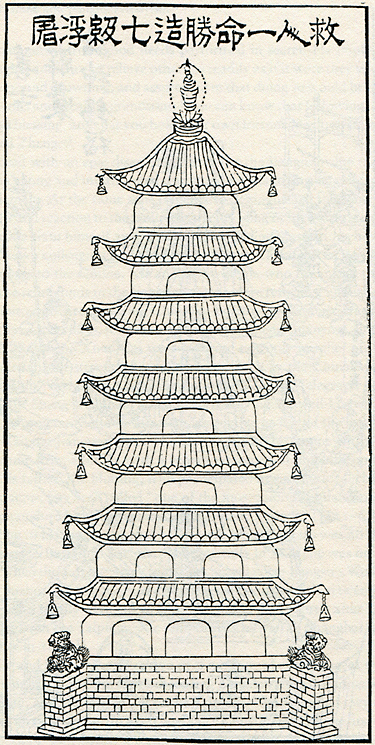 |
 Wild Goose Pagoda for Wild Goose Pagoda for
Shandong Relief—“To save one person’s life is better than building a seven-story pagoda.”
“Si sheng gao zai tu qi,” 3a
[t005]
|
| |
Xie and his co-workers also drew on the belief, popularized by morality books (shanshu), that Heaven distributed rewards and retributions for good and bad deeds. [20] While local-level observers in the famine-stricken northern provinces tended to emphasize Heaven’s wrath at human misconduct in their attempts to explain the famine, Jiangnan philanthropists focused instead on the rewards that generous donors could accrue by donating to relief campaigns.
The “ledgers of merit and demerit” that circulated widely in late imperial China provided detailed advice on what people should do to earn rewards and escape punishments during life on earth and in the afterlife. Such books specifically addressed the religious ramifications of engaging in famine relief activities. One seventeenth-century morality book, for example, allotted 100 merit points to a person who saved the life of another, but deducted 100 points from the account of one who “hoards rice rather than distributing it to the needy in times of famine.” [21] The Taohuawu famine illustrations echoed such claims.
|
|
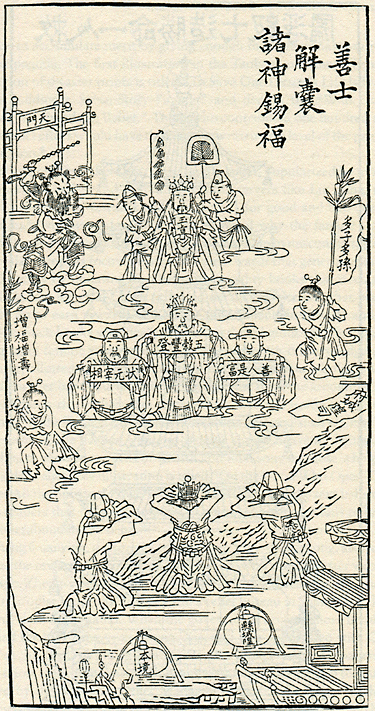 |
 The final print in the Henan qihuang tieleitu shows heavenly beings descending to shower rewards of wealth and filial sons on those who contributed to relief efforts. The illustration is titled “On the Good Who Open Their Purses All the Spiritual Powers Bestow Blessing,” and the text below ensures readers that the accumulation of good actions never fails to result in “superabundant blessing.” [22] The final print in the Henan qihuang tieleitu shows heavenly beings descending to shower rewards of wealth and filial sons on those who contributed to relief efforts. The illustration is titled “On the Good Who Open Their Purses All the Spiritual Powers Bestow Blessing,” and the text below ensures readers that the accumulation of good actions never fails to result in “superabundant blessing.” [22] |
 Philanthropists Rewarded— Philanthropists Rewarded—
“On the good who open their
purses all the spiritual powers
bestow blessing.”
“Si sheng gao zai tu qi,” 19a
[t006]
see also Legge plate XII. | |
| |
Zheng Guanying, a reformer-entrepreneur from Guangdong who played a major role in organizing the Shanghai-based famine relief effort, also highlighted the rewards Heaven would grant those who helped disaster victims. In 1877, Zheng worked with Xie Jiafu and with the Zhejiangese merchant-philanthropist Jing Yuanshan to form a relief bureau to help famine victims in Shanxi. When the government became more involved with relief efforts the following year, Zheng, Xie, and Jing cooperated with Qing officials, particularly Sheng Xuanhuai and Li Hongzhang, to broaden the relief effort to include three more stricken provinces: Henan, Zhili, and Shaanxi. [23]
In a letter to the public that was posted by the Shanghai Relief Managing Office early in 1878, Zheng Guanying reminded “those fortunate people who live in Shanghai and have enough food and warm clothing” that “saving neighbors from disaster brings many good effects.” Great wealth and high rank, he explained, both stemmed from good deeds performed in secret. He implored his Shanghai audience to relieve others as readily as if it were they who were starving and drowning, and assured them that doing so would bring them filial sons and wealthy grandsons. “You can know that following the Way brings blessing, and that you hold your own fortune in your hands,” concluded Zheng. [24]
When faced with a disaster of epic proportions, members of the Jiangnan elite turned to China’s long and multifaceted tradition of philanthropic action and poetic lament. At the same time, there was also much that distinguished their reaction to the famine from late-Ming or hinterland responses. Both Xie Jiafu himself, and the “pictures to draw tears from iron” that he and his Taohuawu colleagues compiled, are representative of the hybrid character of Jiangnan responses to the famine.
Xie and many others who played leading roles in organizing the drive to raise famine relief funds in the Jiangnan region were reformist in outlook and committed to strengthening China by borrowing Western practices. In the 1870s and 1880s, for example, Xie Jiafu, Zheng Guanying, Jing Yuanshan, and Sheng Xuanhuai were involved not only in organizing relief efforts, but also in self-strengthening enterprises such as the China Merchants Steamship Navigation Company or the Shanghai Telegraph Office. [25]
Xie Jiafu provides a useful profile of the less famous post-Taiping Jiangnan elites who responded to the famine with such alacrity. Xie came from a family with a venerable record of engaging in philanthropic activities. His father, Xie Huiting, was involved in multiple kinds of local-level charitable campaigns, and has been called “one of the most famous philanthropists in Jiangnan during the Daoguang and Xianfeng periods” (1821 to 1861). [26] According to his biography, Xie Jiafu was no stranger to disaster. Born into a local-gentry family in 1846, he was only 14 years old when the Taiping Army took over his home village near Suzhou. Xie was captured by the rebels, and more than 20 of his family members were killed. His father died shortly after his son’s escape from the Taipings, and Xie temporarily moved to Shanghai with his mother. [27]
Xie and his mother were two of literally thousands of elite refugees who fled to Shanghai during the 1860s as leading Jiangnan cities fell to the Taipings. The Shanghai they arrived in had already changed a great deal since China’s defeat in the first Opium War (1839 to 1842), which forced the Qing government to open the city to foreign trade and allow British, American, and French authorities to establish foreign concessions there. As it became a major hub for overseas trade as well as for north-south coastal shipping routes and east-west Yangzi commerce, Shanghai developed a distinctive Sino-Western character. [28] By the time the famine spread across North China in the 1870s, Shanghai had become the leading metropolis of the wealthy Jiangnan region and was thus in a premier position to raise relief contributions to aid the starving.
|
|
| |
Selling Women & Children to Survive
|
|
| |
|
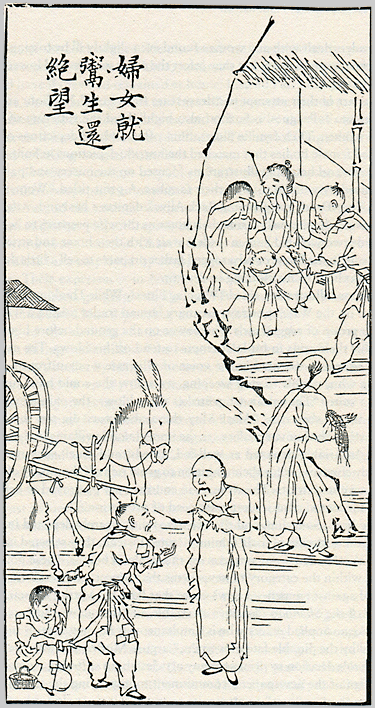 |
 Some illustrations of the famine drew attention to the fact that starving familes often resorted to selling women and children in order to survive. A print titled “Women are Sold: They Despair of Coming Back Alive,” for example, depicts a husband, wife, and child weeping piteously inside their home as the wife prepares to be sold. Outside two well-fed human traders wait with their horse and strings of cash, and in the foreground a ragged father prepares to sell a little daughter who clings to his clothing Some illustrations of the famine drew attention to the fact that starving familes often resorted to selling women and children in order to survive. A print titled “Women are Sold: They Despair of Coming Back Alive,” for example, depicts a husband, wife, and child weeping piteously inside their home as the wife prepares to be sold. Outside two well-fed human traders wait with their horse and strings of cash, and in the foreground a ragged father prepares to sell a little daughter who clings to his clothing
in despair.
A Wife is Sold—“Women are
sold. They despair of coming
back alive.”
“Si sheng gao zai tu qi,” 30a
[t009]
|
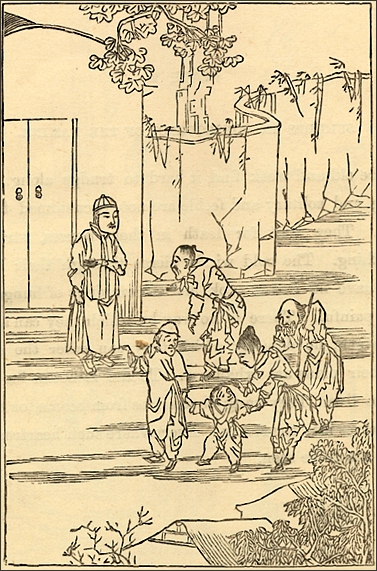 |
  The commentary accompanying an illustration of agonized parents selling their child in the “Tears from Iron” pamphlet points out that the alternative to remaining together in the face of starvation was to The commentary accompanying an illustration of agonized parents selling their child in the “Tears from Iron” pamphlet points out that the alternative to remaining together in the face of starvation was to
“follow one the other to
certain death.”
Parents forced to sell
their children—“They Sell Their Boys and Girls. Parents and Children Part and Their
Bowels are Rent”
[Legge plate IV] |
  Another graphic in the pamphlet depicts this anguish in two tiers. At the bottom of the picture, a grey-haired couple agonize over the need to sell their only grandchild. In a room above them, we see their starving filial son and his faithful wife stifling Another graphic in the pamphlet depicts this anguish in two tiers. At the bottom of the picture, a grey-haired couple agonize over the need to sell their only grandchild. In a room above them, we see their starving filial son and his faithful wife stifling
their cries.
A grey-haired couple consider selling their only grandson—
“A Filial Son and a Faithful
Wife Enduring Hunger and
Stifling Their Cries”
[Legge plate IX]
|
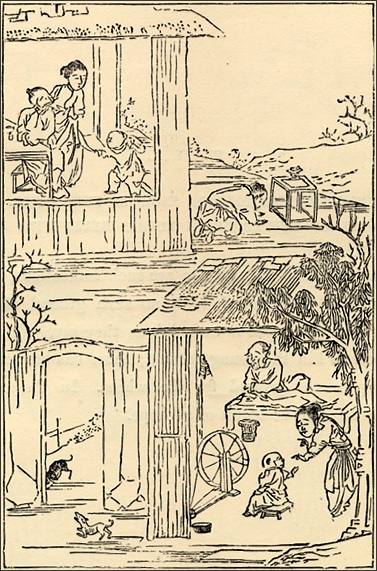
|
| |
During his time in Shanghai, Xie Jiafu became more and more interested in current and foreign affairs. At one point he encountered a Japanese official who told him about Japan’s reforms under the Meiji government. Xie was impressed by what he heard of those reforms, and decided to study foreign methods. He then entered the map department of a local school, where he familiarized himself with world maps and studied foreign languages with a German man he met at the school. He became acutely aware of the importance of coastal defense and commerce. After studying for some time, he started to compile and publish Western books about foreign affairs. [29]
Before the famine struck, Xie returned to Suzhou and resided at the Taohuawu hall. There he began to expand the reach of his father’s charitable activities. In the spring of 1877, while returning from conducting relief work among disaster victims in northern Jiangsu Province, he heard the disturbing news that foreign missionaries in Shandong were adopting orphaned children from famine districts. Possibly because rumors that Catholic orphanages took in abandoned Chinese children in order to sever their limbs or gouge out their hearts had circulated widely in China since the 1860s, Xie and many of his compatriots responded with suspicion to reports about missionaries taking in Chinese famine orphans. [30] Moved by the plight of the orphans and unwilling to see more of them handed over to foreigners, Xie began to raise relief contributions for famine-stricken Shandong. When other members of the Jiangnan elite heard of his intention, they donated large sums of money. Xie then traveled to Shandong, where he used the money he had raised to purchase a shelter and build a charitable school for the famine orphans. After returning from Shandong once the crisis there had eased, early in 1878 Xie mobilized gentry-philanthropists in several different Jiangnan cities to start a relief campaign for Henan. [31]
From then on, claimed Xie’s effusive biography, people from six different provinces begged Xie for assistance when faced with famine. In response, he worked “from morning to night” to prepare woodblock prints (presumably the tieleitu) that publicized the plight of disaster victims. Because many were moved by Xie’s work, he was able to collect over 2,500,000 taels for relief, thus saving the lives of countless people. Xie was highly praised by the Shenbao, and did not go unrewarded after the famine. He received a position at the Shanghai Telegraph Office, which was headed by two of his famine-relief colleagues, Sheng Xuanhuai and Jing Yuanshang. [32]
Stepping into the vacuum left by the decline of Qing officialdom, Xie and other Jiangnan philanthropists used their money, energy, and talent to act as de facto officials who raised people’s awareness of the disaster, collected and distributed famine relief funds, promulgated detailed regulations about how to conduct relief work, and redeemed women and children who had been sold. Xie and his Taohuawu public hall, for example, established the “Qingjiang Bureau for Redeeming and Sending People Back,” which sought to help women and children from famine districts who had been sold by their starving families. [33]
The Qingjiang Bureau spent most of the money that it received from wealthy donors to redeem women, build temporary sheds to house them in, give the women clothing, bedding, and food, provide relief for their families, and hire soldiers to escort them home. Those in charge of the Qingjiang Bureau also kept meticulous records listing the name, age, native place, and surviving family members of the 43 women rescued. Of the nine girls and women given money and escorted back to their native places in March 1879, for example, three were from Shandong and six from Zhili, and they ranged from eight to 17 years of age. Some were returned to family members, while those who lacked any family at all were sent to a benevolence hall in Tianjin to be cared for. [34]
Several of the “tears from iron” illustrations highlight the Taohuawu public hall’s commitment to raising awareness of and relief funds for women and children who had been sold by their starving families. Some illustrations focus on the pain and suffering caused when famished family members were separated.
|
|
| |

|
|
|





